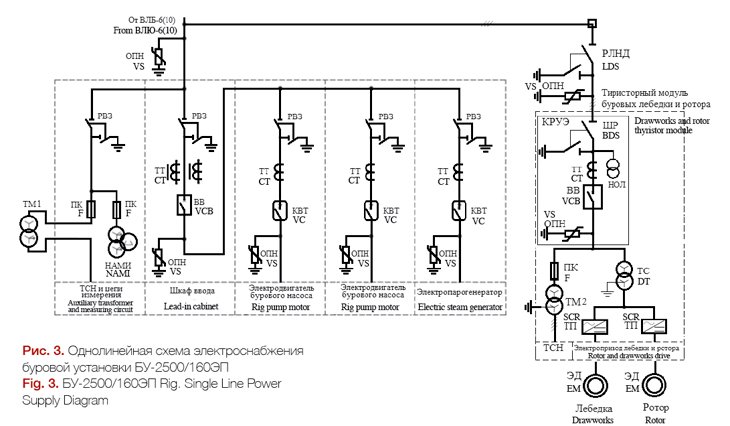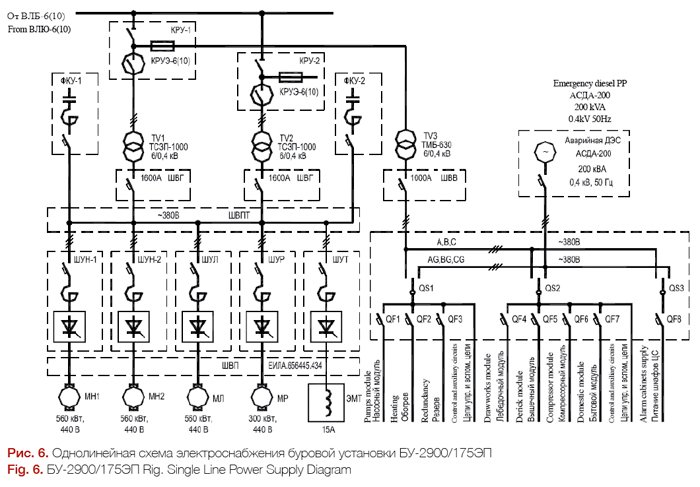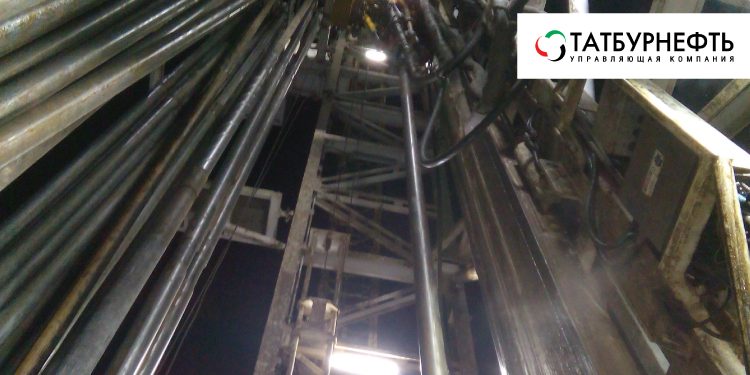Drilling Rigs’ Power Supply: Methods to Enhance The Reliability of The Drawworks Drive Power Supply
This article describes the power supply schemes that ‘UK ‘Tatburneft’ Ltd apply to different process equipment configurations. It also shows the commercial power supply schemes for the rigs with controlled and non-controlled main machinery electric drives. The article delivers the methods to enhance the reliability of the drawworks drive power supply. In order to establish reliable feeding of the drawworks drive and to avoid sticking while drilling (caused by the loss of the drawworks power supply), the author suggests that the rig equipment should be shut off in sequential manner to decrease the load of the rig power source.
In Russia, most of the drilling works are handled by the rigs with electric drives [1]. Using either of the power supply schemes depends on the following:
• main machinery drive type (controlled electrical; non-controlled electrical; diesel-electrical; diesel);
• power voltage level;
• equipment layout. The HV linear unit (ВЛБ-6(10) connected to the 6 or 10kV field network is the common feature of all rigs with electric drives. Figure
1 shows ВЛБ-6(10) single line diagram with voltage suppressors (VS); linear disconnecting switch (LDS); HV disconnecting switch with grounding blades (РВЗ); current transformers (CT); fuses (F); voltage transformer (NAMI) and vacuum circuit breaker (VCB).


The high voltage linear unit consists of the outdoor cabinet with HV switching and metering equipment, relay protection and commercial electrical meter.
Depending on the field network voltage level, the ВЛБ-6(10) HV unit will be equipped with the NAMI voltage transformer set on the correct voltage level. The rest of equipment is designed for 10kV, for the purpose of unification.
If the rig is powered from 10kV network, a 10-6kV matching transformer should be installed in addition, on the same foundation with the ВЛБ-6(10) HV unit.
Depending on the equipment configuration – rig pumps type; electric steam generators availability for the winter period; rig type, depending on the drilling conditions and the well TD; top drive availability; circulation system type etc., the power supply system will be different for every well pad. That is the reason that prior to having the rig connected to the field network, a power supply design that incorporates all conditions and field specific, is required.

Figure 2 shows the old rigs single line power supply diagram with the outdoor PCG (packaged switchgear) (КРУНБ-6)
The КРУНБ-6 PCG consists of six cabinets: auxiliary transformer cabinet (for auxiliary, protection and metering devices); lead in cabinet; motors and electric steam generators cabinets with vacuum contactors.

Depending on the application, the number of the КРУНБ-6 PCG cabinets may vary. Figure 3 shows БУ-2500/160ЭП Rig Single Line Power Supply Diagram with КРУНБ-6 PCG, consisting of five cabinets. This application uses two rig pumps with AC driven synchronous motors; drawworks and rotor electric drive – controlled-type, with AC thyristor drive. Drawworks and rotor thyristor module with HV lead in contains disconnecting switches, voltage suppressors, vacuum circuit breaker, auxiliary transformer and thyristor rectifiers power transformer.

Figure 4 shows a single line power supply diagram of the following rigs: БУ-75БрЭ, БУ-1600/100ЭУ with КРУНБ-6 PCG, consisting of four cabinets. This configuration uses the rig pump with VFD. The packaged switchgear shares the module with the frequency converter.

Figure 5 shows a single line power supply diagram of the БУ-2000/125ЭП rig where the main machinery is equipped with the DC electric drive.

Figure 6 shows single line power supply diagram of the БУ-2900/175ЭП rig with main machinery with DC electric drives.

Figure 7 shows a single line power supply diagram of СБУ (МБУ) – 3000/175ИЭ rig (stationary and mobile) with VFD-driven main machinery.
Complications such as sticking entail bigger downtime compared to other failures and emergencies and therefore require more time to respond. A power failure could cause the drill pipe and casing to stick. To enhance reliability and stability of the rig systems by shortening the response time and decreasing the downtime of equipment, it is necessary to develop the drawworks power failure protection device.
Drawworks Power Failure Protection Device [2]. The rigs PCG overcurrent protection [3] consists of the current transformers and the overcurrent relays. The overcurrent relays shall be adjusted so that once the motor is overloaded, the relevant contactor would trip; and in case of the short-circuit, the lead in switch in ВЛБ-6(10) kV unit would trip.
Such relay protection has the following deficiencies:
First, low reliability: the entire rig would trip should the overcurrent setting be exceeded and the lead-in switch open. This is explained with the fact that the total rated power of the rig equipment almost two times exceeds the top theoretical maximal load limits; that is why the rig receivers cannot turn on at the same time. For example, the drawworks and rotor drives cannot operate simultaneously; the rig pumps and drawworks drives always actuate at different time; however, the rig pump and rotor drive, or the top drive and auxiliary equipment drives can work operate simultaneously. That is why, depending on the well design, the rig load is uneven, which is what triggers the false response of the lead-in switch;
Second, the low efficiency is due to the lead-in switch trip in case of the short-circuit on one of the motor’s busbar, which leads to the full stop of the drilling operations.
The device, shown in Figure 8, can help with the following: enhance the reliability of the uninterrupted drawworks drive operation by enabling the emergency POOH in order to avoid sticking in case of the power unit failure; improve the relay protection efficiency by increasing the drawworks drive power loss protection degree.
This technical challenge can be resolved with the drawworks drive power loss protection device that consists of the monitoring unit, which input is connected to the PCG busbar section lead-in current, and the first, the second and the third timers with actuators.
The device’s work concept is the following:
When the current setting value (I) is reached, the overcurrent monitoring unit 1 is actuated to send a signal to the first timer 2; then the t1 time countdown starts. When the t1 time on the first timer 2 expires, the additional units 5, 6 and 7 are actuated to switch off the relevant drives of the rotor, rig pump and the top drive system. The drawworks drive remains ON. At the same time, the alarm unit 8 issues an «Emergency POOH» signal to the driller’s panel, indicating the need to pull the tool (DP or casing strings are not shown on Figure) out of the hole to avoid sticking in case of the rig power supply failure. It allows to fully avoid the sticking, or at least minimize, its consequences.

If the current (I) keeps growing, the overcurrent monitoring unit 1 will send a signal to the second timer 3, and the t2 time countdown will start (t2>t1). When the t2 time on the second timer 3 runs off, the actuator 9 is actuated (the second power supply loss protection stage) to shutoff the drawworks drive; at this, the auxiliary rig machinery will stay ON, including the emergency drawworks drive, which allows emergency POOH. If the current (I) is still increasing, the overcurrent monitoring unit 1 sends the signal to the third timer 4, and the t3 time countdown runs (t3>t2>t1). When the t3 time on the third timer 4 expires, the actuator 10 of the third protection stage will be activated to trip the PCG busbar section lead-in switch.
The proposed device has three protection stages against the drawworks drive power supply loss:
• first stage (top drive, rig rotor and rig pump drives trip);
• second stage (drawworks drive trip);
• third stage (PCG busbar section lead-in switch trip).
This helps enhance the rig systems efficiency by decreasing the protection response time, avoid false trips and reduce the downtime of the rig equipment (pump, rotor, top drive, auxiliary machinery).

Auxiliary (Emergency) Drawworks Drive Power Loss Protection Device [4]. The weak point of the said device, is that if the power unit fails, it will result in full loss of the emergency drawworks drive power supply. That is why ‘UK ‘Tatburneft’ Ltd has developed a device (Figure 9) aimed to enhance the reliability of uninterrupted emergency drawworks drive operation by enabling emergency POOH in case of the power unit failure. It is required to avoid sticking, and to enhance the device operation efficiency by increasing the degree of the emergency drawworks drive power loss protection.
The device work concept is the following:
When the current setting value (I) is reached, the overcurrent monitoring unit 1 is actuated to send a signal to the first timer 2; then the t1 time countdown starts.
When the t1 time on the first timer 2 expires, the additional units 5, 6 and 7 are actuated to switch off the relevant drives of the rotor, rig pump and the top drive system. The drawworks drive remains ON.
At the same time, the alarm unit 8 sends the «Emergency POOH» signal to the driller’s panel; and the unit 8a issues a signal to start the emergency diesel (not shown on figure).
The unit 8 signal indicates the need to pull the tool (DP or casing strings are not shown on Figure) out of the hole to avoid sticking in case of the rig power supply failure. It allows to fully avoid the sticking, or at least minimize, its consequences.
The Unit 8a signal is needed in order to prepare the diesel generator in case of full power loss.
If the current (I) keeps growing, the overcurrent monitoring unit 1 will send a signal to the second timer 3, and the t2 time countdown will start (t2>t1).
When the t2 time on the second timer 3 runs off, the actuator 9 is actuated (the second power supply loss protection stage) to shutoff the drawworks drive; at this, the auxiliary rig machinery will stay ON, including the emergency drawworks drive, which allows emergency POOH.
If the current (I) is still increasing, the overcurrent monitoring unit 1 sends a signal to the third timer 4, and the t3 time countdown runs (t3>t2>t1).
When the t3 time on the third timer 4 expires, the actuator 10 of the third protection stage will be activated, to trip the PCG busbar section lead-in switch.
When the t4 time of the fourth timer 4a runs out, the 4th protection stage actuator 10a is activated to supply the power from the diesel generator to the auxiliary rig machinery, to which the emergency drawworks drive belongs (which allows emergency POOH).
The 4a timer is needed to ensure the time interval sufficient to trip the PCG busbar section lead-in switch; to avoid the feedback in transformer circuit; and to supply the power to the failed network section.
The first time the Drawworks Power Failure Protection Device was applied on was well 30150 (‘Dzhalilneft’ Production, PAO ‘Tatneft’), and with the following hardware: microcontroller multichannel time relay and remote radio modules. The economic benefit was over 600K roubles for one rig, due to reduced drilling crew downtime.
In conclusion it should be said that the actual economic benefit will be much higher, as the feasibility survey did not incorporate any expenses connected with emergencies caused by the drawworks power failure; the feasibility survey also did not consider the intermitted operations and the auxiliary operations; the losses related to equipment restart after the power restoring; nor the downtime losses (time on waiting until the failure gets fixed).
Conclusions
Depending on the drilling conditions and the well TD; whether the top drive is available; the mud system etc., the power supply scheme mayvary for every pad. The suggested drawworks drive power supply loss protection devices reduce the chance of sticking in case of the power failure.
Bibliography
1. Abramov B.I., Avdiyski E.I., Kogan A.I., Kozhakov O.I., Motsokhein B.I., Parfenov B.M. Modern and Prospective Power Equipment for the Rigs with up to 3900m Depth Capacity / Electrotekhnika, 2001, №1, p. 11-16.
2. Patent of the RF 2540947. Drawworks Drive Power Supply Loss Protection Device / Shafigullin R.I., Yeromasov V.G., Andiryakov V.F., Nikulin О.V., Announced on 10.03.2015. Published on 10.07.2016 Bull. № 19.
3. S.G. Blanter, I.I. ‘Power Equipment for Petroleum Industry’, Publ. Comp. ‘Nedra’, 1973.
4. Patent of the RF # 166093. Energency Drawworks Drive Power Supply Loss Protection Device / Nazipov L.L., Andiryakov V.F., Nikulin O.V., Kurbangalin R.R., Soldatkin D.V., Announced on 10.06.2016. Published on 20.11.2016 Bull. № 32.
Nikulin OV, Ph.D.,
Lead Engineer, Tatburneft (UK)



